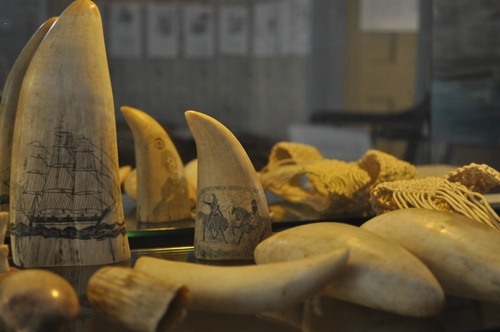Photos: Whaling exhibit displays artifacts from historic industry

Southold’s Sam Gardiner once wrote:
“Death unto the living
Success unto the Killer
And here’s to the health of the sailor’s wives
And greasy luck to the whalers.”
That was written more than a century ago about an industry that no longer exists here. But whaling is intrinsically tied to Greenport as a part of its history and development as a maritime village, according to local historian Gail Horton.
“There were 72 whaling ports [in the U.S.] and we were number 17,” Ms. Horton said of Greenport at the Stirling Historical Society’s whaling exhibit, which will be on display through Sept. 2 and also on Columbus Day weekend. The exhibit, “Blow, Thar She Blows!” chronicles Greenport’s active whaling years, which began in the early 19th century and ended in the late 1850s. More than 100 ships operated out of the village during those years.
[nggallery id=369 template=galleryview]
A large model of the whaling ship Neva is the exhibit’s centerpiece.
“Our getting to borrow this model was the genesis of the exhibit,” Ms. Horton said. “It was made by the ship’s captain, Nathaniel Case, and was the ship that brought Manuel Claudio to Greenport after signing the 12-year-old on as a crew member in a cluster of Portuguese Islands called the Azores in 1851.”
Southold resident Cliff Benfield, a collector of whaling artifacts, said Neva was condemned upon its arrival in Greenport in 1857, making the village the last stop for both the ship and Mr. Claudio.
A story displayed on the wall at the exhibit entrance tells the story of another vessel, Manhattan, which became the first American ship to visit Japan in 1845. Manhattan, captained by Mercator Cooper, rescued some Japanese sailors from a wreck that year and was allowed to return them to Tokyo. The emperor of Japan was delighted by the dark skin of Pyrrhus Concer, a black crewman who entertained the emperor with spirituals and other songs he often sang on deck.
One of the Japanese sailors returned to America on Manhattan, as did the captain’s log book from the Japanese shipwreck and maps of Japan, which Captain Cooper quietly took, according to Mr. Benfield, who added that they were the United States’ first maps of the area going into World War II.
The exhibit notes that 20 percent of whalers were “of color.” Ms. Horton added that “Greenport has become the wonderful diverse place it is today largely because of whaling.”
Many of Greenport’s whaling ships were later sold to the government and used in the Civil War.
“Greenport lost its entire fleet of whaling ships in the Civil War,” said Mr. Benfield, who has been collecting whaling artifacts for more than half a century. “The government bought them, took them out to Charleston Harbor and then sunk them in order to barricade the harbor from enemy ships.”
Mr. Benfield lent the historical society several whaling tools and scrimshaw — items carved by whalers from whale teeth and bones and walrus tusks — most of which were made in Suffolk County.
“Captains believed the devil made work for idle hands, so they made sure a certain amount of whalebone was available for the men to make things out of them,” Mr. Benfield said of his artifacts.
The most popular item made was a “fid,” a small needle-pointed object used to help undo knots. Other popular items were miniature domino sets, napkin rings, walking canes, tongue scrapers and cigar holders.
“People ask how these sailors could carve into that hard stuff, but they’re soft when they’re new and fresh,” Mr. Benfield said of whalebones and teeth. “If you want to know where you can find whalebone, I suggest you go through your mother’s button box because whalebone buttons were often used for suspenders.”
Displayed in the case with the scrimshaw is a medical manual written by Dr. Ezekiel Skinner, a surveyor of the port during the Filmore, Lincoln, Johnson and Grant administrations and an ancestor of current Southold Zoning Board of Appeals member David Corwin.
Copies of pages from the manual that describe suggested methods of treating scurvy, venereal disease, wounds, bilious fever and inflammations of the brain or bowels are blown up and displayed on the nearby wall for visitors to read.
This information and more, including how crew members brought down their prey, is on view at the Stirling Historical Society, 319 Main Street in Greenport, between 1 and 4 p.m. Saturdays and Sundays.


